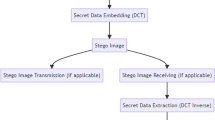Abstract
In this paper, a reversible data hiding scheme for digital images with high hiding capacity is proposed. Original image is segmented into smooth and rough regions based on local complexity. In order to achieve higher hiding capacity, we embed three bits into each pixel belonging to smooth region with lower local complexity and one bit is embedded into each pixel of rough region, which can effectively exploit more redundancy during data embedding compared with conventional methods of prediction error expansion (PEE). Additionally, the pixel selection mechanism is applied to reduce the number of shifted pixels, which leads to high visual quality of stego image. Experimental results show that, our scheme can achieve better rate-distortion performance than some of state-of-the-art schemes.







Similar content being viewed by others
References
Celik MU, Sharma G, Tekalp AM, Saber E (2005) Lossless generalized-LSB data embedding. IEEE Trans Image Process 14(2):253–266
Fallahpour M (2008) Reversible image data hiding based on gradient adjusted prediction. IEICE Electron Express 5(20):870–876
Hong W, Chen TS, Wu HY (2012) An improved reversible data hiding in encrypted images using side match. IEEE Signal Process Lett 19(4):199–202
Hong W, Chen TS, Chen J (2015) Reversible data hiding using Delaunay triangulation and selective embedment. Inf Sci 308:140–154
Hong W, Zheng S, Chen TS, Huang CC (2016) Reversible data hiding in block truncation coding compressed images using quantization level swapping and shifting. KSII Trans Internet Inf Syst 10(6):2817–2834
Hu Y, Lee HK, Li J (2009) DE-based reversible data hiding with improved overflow location map. IEEE Trans Circuits Syst Video Technol 19(2):250–260
Li XL, Yang B, Zeng T (2011) Efficient reversible watermarking based on adaptive prediction-error expansion and pixel selection. IEEE Trans Image Process 20(12):3524–3533
Li XL, Li B, Yang B, Zeng TY (2013) General framework to histogram-shifting-based reversible data hiding. IEEE Trans Image Process 22(6):2181–2191
Li XL, Zhang WM, Gui XL, Yang B (2015) Efficient reversible data hiding based on multiple histograms modification. IEEE Trans Inf Forensics Secur 10(9):2016–2027
Liu JF, Tian YG, Han T, Wang JC, Luo XY (2016) Stego key searching for LSB steganography on JPEG decompressed image. SCIENCE CHINA Inf Sci 59(3):1–15
Lu TC, Chi LP, Wu CH, Chang HP (2017) Reversible data hiding in dual stego-images using frequency-based encoding strategy. Multimedia Tools and Applications 76(22):23903–23929
Luo L, Chen Z, Chen M, Zeng X, Xiong Z (2010) Reversible image watermarking using interpolation technique. IEEE Trans Inf Forensics Secur 5(1):187–193
Ma YY, Luo XY, Li XL, Bao ZK, Zhang Y (2018) Selection of rich model Steganalysis features based on decision rough set α-positive region reduction. IEEE Trans Circuits Syst Video Technol. https://doi.org/10.1109/TCSVT.2018.2799243
Ni ZC, Shi YQ, Ansari N, Su W (2006) Reversible data hiding. IEEE Trans Circuits Syst Video Technol 16(3):354–362
Ou B, Li XL, Zhao Y, Ni RR, Shi YQ (2013) Pairwise prediction-error expansion for efficient reversible data hiding. IEEE Trans Image Process 22(12):5010–5021
Qian ZX, Zhang XP (2016) Reversible data hiding in encrypted image with distributed source encoding. IEEE Trans Circuits Syst Video Technol 26(4):636–646
Qian ZX, Zhang XP, Wang SZ (2014) Reversible data hiding in encrypted JPEG bitstream. IEEE Trans Multimed 16(5):1486–1491
Qin C, Zhang XP (2015) Effective reversible data hiding in encrypted image with privacy protection for image content. J Vis Commun Image Represent 31:154–164
Qin C, Chang CC, Huang YH, Liao LT (2013) An inpainting-assisted reversible steganographic scheme using a histogram shifting mechanism. IEEE Trans Circuits Syst Video Technol 23(7):1109–1118
Qin C, Chang CC, Chiu YP (2014) A novel joint data-hiding and compression scheme based on SMVQ and image inpainting. IEEE Trans Image Process 23(3):969–978
Qin C, Chang CC, Hsu TJ (2015) Reversible data hiding scheme based on exploiting modification direction with two steganographic images. Multimed Tools Appl 74(15):5861–5872
Qin C, Chen XQ, Ye DP, Wang JW, Sun XM (2016) A novel image hashing scheme with perceptual robustness using block truncation coding. Inf Sci 361–362:84–99
Qin C, Ji P, Zhang XP, Dong J, Wang JW (2017) Fragile image watermarking with pixel-wise recovery based on overlapping embedding strategy. Signal Process 138:280–293
Qin C, Ji P, Chang CC, Dong J, Sun XM (2018) Non-uniform watermark sharing based on optimal iterative BTC for image tampering recovery. IEEE Multimedia. https://doi.org/10.1109/MMUL.2018.112142509
Qin C, Chen XQ, Luo XY, Zhang XP, Sun XM (2018) Perceptual image hashing via dual-cross pattern encoding and salient structure detection. Inf Sci 423:284–302
Sachnev V, Kim HJ, Nam J, Suresh S, Shi Y (2009) Reversible watermarking algorithm using sorting and prediction. IEEE Trans Circuits Syst Video Technol 19:989–999
Tai WL, Yeh CM, Chang CC (2009) Reversible data hiding based on histogram modification of pixel differences. IEEE Trans Circuits Syst Video Technol 19(6):906–910
Thodi DM, Rodriguez JJ (2007) Expansion embedding techniques for reversible watermarking. IEEE Trans Image Process 16(3):721–730
Tian J (2003) Reversible data embedding using a difference expansion. IEEE Trans Circuits Syst Video Technol 13(8):890–896
Zhang XP (2012) Separable reversible data hiding in encrypted image. IEEE Trans Inf Forensics Secur 7(2):526–532
Zhang Y, Qin C, Zhang WM, Liu FL, Luo XY (2018) On the fault-tolerant performance for a class of robust image steganography. Signal Process 146:99–111
Acknowledgments
This work was supported by the National Natural Science Foundation of China (61171126, 61272452, 61702332, U1636101, 61562007), Ministry of Transport and Applied Basic Research Projects (2014329810060), and Science & Technology Program of Shanghai Maritime University (20130479), Natural Science Foundation of Guangxi (2017GXNSFAA198222), and Research Fund of Guangxi Key Lab of Multi-source Information Mining & Security (MIMS15-03).
Author information
Authors and Affiliations
Corresponding authors
Rights and permissions
About this article
Cite this article
Cao, F., An, B., Yao, H. et al. Local complexity based adaptive embedding mechanism for reversible data hiding in digital images. Multimed Tools Appl 78, 7911–7926 (2019). https://doi.org/10.1007/s11042-018-6031-4
Received:
Revised:
Accepted:
Published:
Issue Date:
DOI: https://doi.org/10.1007/s11042-018-6031-4




